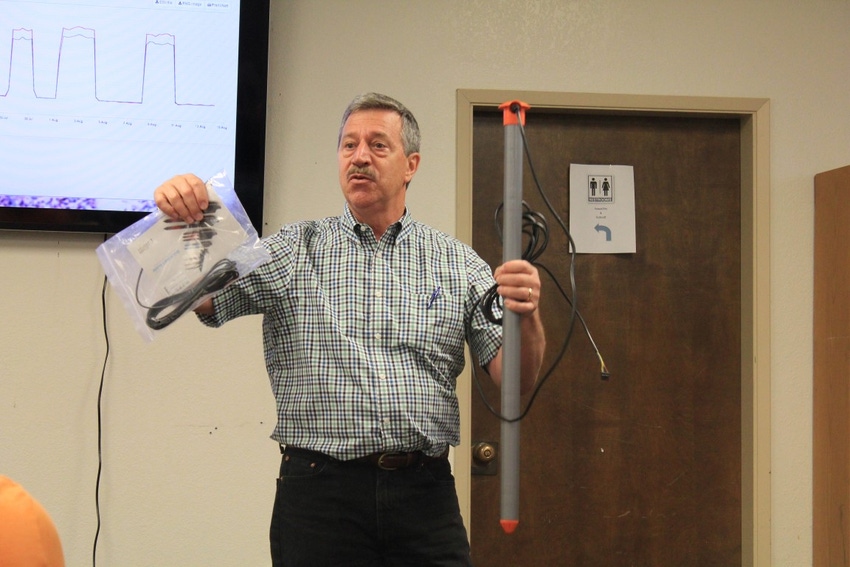August 27, 2014

Before launching into a discussion of what he sees as the need for high tech gadgetry to bring greater efficiency to water use on crops that include pistachios, Phil Reh opened a talk at Fresno State University with an interesting observation.
“The best moisture soil sensor in the world is you and a shovel and a good boot, digging a hole and going down into the root zone,” said Reh, director of sales and business development with Observant Inc.
But that sort of hands-on approach “is not practical with the acreages and all the crops people manage today,” Reh said, “so we’re turning to sensors.”
Observant, started 10 years ago in Australia, expanded into the U.S. market just this year, launching in February at the World Ag Expo in Tulare. In recent months, its monitoring equipment has found its way onto the campus farm at Fresno State.
On the campus, an Observant camera keeps an eye on the level in a reservoir that sits between a field of sugar beets and a pistachio orchard. The camera – and other monitors on gauges in a building beside the reservoir – saves managers of campus crops trips to the site. They simply access information with a cell phone.
Reh, based in Sacramento, explained that Observant first started as a way to keep tabs on the water levels in stock tanks on huge cattle ranches in Australia.
Its products and applications allow monitoring and control of water use, irrigation systems, valves, gates, diesel engine and electric pumps, renewable energy monitoring and agricultural pump management systems.
Document water use
In its first year at Fresno State, Reh said, one goal is to document water use, to know exactly what is going on in the pistachio orchard, for example by measuring the results of each irrigation.
Reh was among speakers at a program presented by the Fresno State Center for Irrigation Technology and the Ag/Water Energy Center. Others also looked at monitoring devices, distribution uniformity and design, and the maintenance of irrigation systems.
All addressed the virtues of how new technology can save water, energy, labor, and other resources.
Reh said the return on investment can come in as little as “one or two crop years.” He contends learning use of the new technology and “how to read a soil moisture draft” need not be daunting.
He adds that Observant systems can employ a wide array of equipment, and the data that is gathered can be shared with others or kept private.
“It’s your orchard, it’s your data,” Reh said.
Bill Green, education manager of the Center for Irrigation Technology, talked of the importance of distribution uniformity and said the Fresno State pistachio orchard gets pretty high marks in that regard despite some sloping elevation and other challenges.
He said the orchard has some missing or plugged emitters and some leaks. He believes some pumps could be downsized in horsepower if filtration were improved and pressure regulation bettered.
Green warned that even excellent distribution uniformity does not assure efficient irrigation practices. For example, it does not prevent over-watering and sending water and nutrients past the root zone.
Real-time monitoring
Pat Biddy, irrigation technology specialist with Irrigation Matters in Tulare, talked of how real-time monitoring can tip off managers to a variety of problems, from high bicarbonates plugging a drip line to a broken acid controller to bacteria buildup.
He used an often-quoted observation: “You can’t manage what you don’t measure.”
Biddy talked of how acid flushing can clean irrigation lines and copper sulfate can clean algae from lines. He said the choice of location for weather stations can be critical, noting that placing them too high above a canopy is not good.
When it comes to moisture sensors, he said, tension based readings are good, use of neutron probes or a diviner is better, and real time readings every 15 minutes from capacitance probes or single point sensors is best.
Biddy recommends that a distribution uniformity test be done before moisture sensors are put in.
From the audience, Robert Wample, formerly head of the FSU Department of Viticulture and Enology, championed a need to take into account variability of soil types when using the new technology. Now a private consultant, he has done some work with Fresno State on the variability of soils in the pistachio orchard.
“You need to dial in soil characteristics,” Wample said.
Rick Dennis, Visalia regional manager with Agri-Valley Irrigation Inc., and Micah Bowman, a professional engineer with Agri-Valley in Fresno, talked of irrigation system design and maintenance.
Bowman offered formulas that could be used to adjust application rates to meet evapotranspiration rates, down to calculating the flow rate per tree. He also advised on selecting emitter types, choosing between drip and jets, along with the spacing of emitters.
“The power cost is typically the most expensive piece of the irrigation system over the long term,” he said.
Bowman also talked of filter selection, and Dennis said it’s very important to learn to manage the back flush system with sand filters.
The two also stressed checking flow rates and pressures at the pump to make sure the system is operating properly, monitoring for leaks and consistent wetting patterns of emitters, and checking pressures of valves downstream.
They recommend analyzing the water to determine the concentration of chemical substances dissolved and suspended in the water. And they recommend flushing lines at the beginning of the season, once a month and at the end of the season.
You May Also Like




